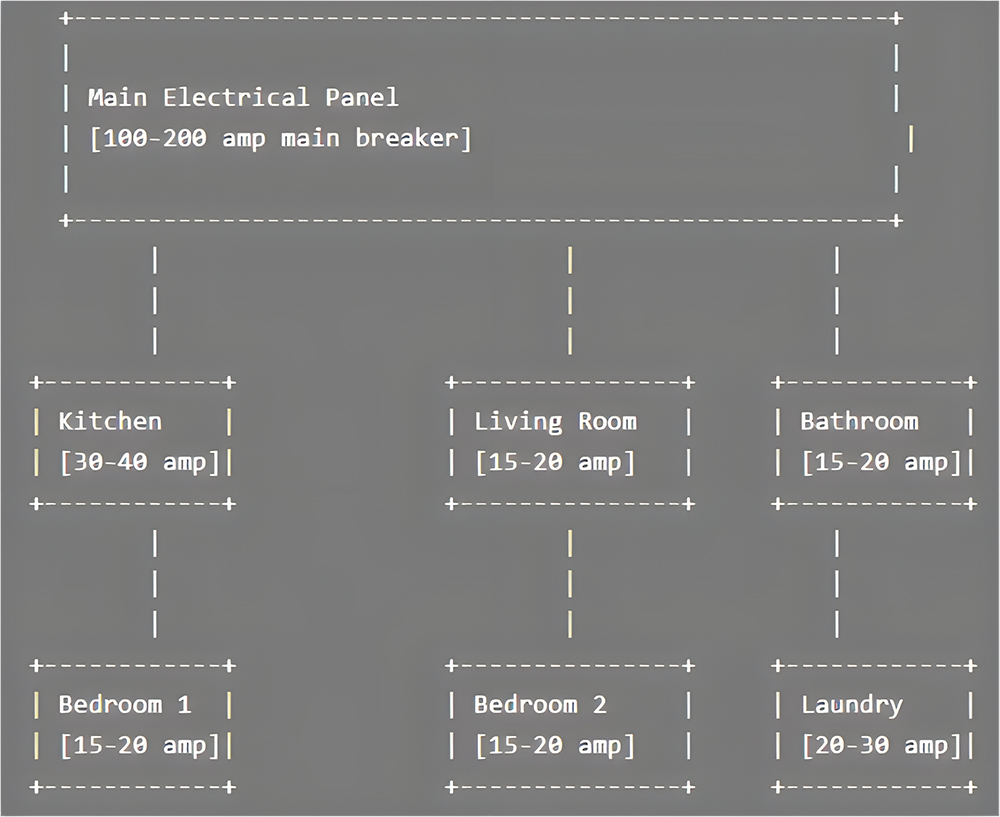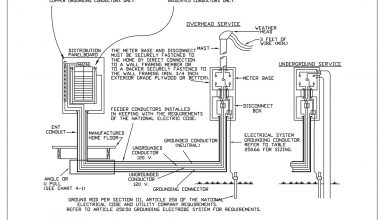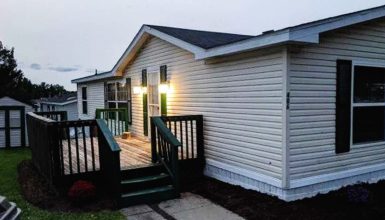Understanding the electrical systems in your mobile home isn’t just for the tech-savvy or the electrically inclined. It’s essential know-how for anyone who calls a mobile home their castle. Why? Because the better you understand your home’s electrical systems, the safer and more efficient your home will be. So, let’s plug in and unravel the mysteries behind what keeps your lights shining, your fridge humming, and your TV streaming your favorite shows. Ready? Let’s get this show on the road!
Main Electrical Panel
The Main Electrical Panel is like the command center in a sci-fi movie, only instead of launching rockets, it’s pitching electricity to all corners of your mobile home. Trust me, this box is the boss of all the electrical happenings around you.
First thing first, let’s talk about the main breaker. This is the big kahuna that controls the maximum amount of electricity flowing into your home. Typically, you’re looking at a main breaker rated between 100 to 200 amps. Think of it as the guardian of your electrical galaxy; if anything goes haywire, this breaker steps in to shut the power off, preventing your circuits from overloading.
Now, your main panel is also packed with smaller breakers, each governing its own little electrical district in your home. The kitchen has its own? Check. Bathroom? Yep. These are called “branch circuits,” and we’ll get more into those in a bit.
What’s super cool about the central panel is its organizational genius. Each breaker is usually labeled to tell you what area of the home it controls. You’ll often find these labels right on the door of the panel. So, next time a fuse blows while you’re microwaving popcorn and blow-drying your hair—hey, we’ve all been there—you’ll know exactly where to go to restore peace and electricity.
The main panel is often hidden away in a utility closet or outside your home in a weatherproof box. It’s not exactly the centerpiece of any room. Still, it’s absolutely the star of the show regarding your mobile home’s electrical system.
Remember, call in a certified electrician if you ever need to do more than just flip a breaker switch. Messing with the main panel without proper know-how is like poking a bear—dangerous and not recommended.
Branch Circuits
We’ve chatted about the heart of your home’s electrical system—the main panel—it’s time to follow the flow and talk about the arteries. Yep, you guessed it: branch circuits! These bad boys are the workhorses that carry electricity from the main panel straight to the outlets and fixtures in each room. Think of them as the highways of your electrical landscape.
So, let’s break it down. You’ve got two main types of branch circuits: 15-amp and 20-amp. The 15-amp circuits are your everyday heroes. They’re great for powering up your lights, charging your phone, and running smaller appliances like your coffee maker. The 20-amp circuits are the heavy lifters, taking care of larger appliances like the dishwasher or the washing machine.
Now, you might be wondering, “How do I tell them apart?” Great question! The easiest way is to check the breakers in your main panel. They’re usually labeled with the amp rating, so you’ll see a ’15’ or ’20’ stamped right on them. Easy-peasy!
You’ll often find that the rooms in your home share a circuit. For example, your living room and hallway lights might be buddies on the same 15-amp circuit. But certain rooms get VIP treatment with their dedicated circuits. We’re talking about your kitchen, bathroom, and laundry room—basically, places where you’ve got some heavy-duty electrical needs or water is in play.
Speaking of water, have you ever heard of a GFCI outlet? If not, no worries—we’ll dive into that life-saving gadget a little later. For now, just know they’re super important for wet areas like the kitchen and bathroom.
And here’s a pro tip: if you’re ever in doubt about what’s connected to what, there’s a simple way to figure it out. Flip the breaker off and see what goes dark or stops working. Just make sure to let everyone in the house know what you’re up to first—no need to create a mini “lights-out” panic!
Powering the Kitchen
The kitchen is like the VIP lounge of electrical circuits. Heavy-duty appliances like your refrigerator, dishwasher, and oven need more oomph than your average table lamp. So naturally, the kitchen gets special treatment with its heavy-duty circuits.
Typically, you’re looking at 30 to 40-amp circuits for those big appliances. Your electric stove, for example, needs a lot more power than your blender. That’s why it gets a dedicated circuit all to itself. Your fridge, too, usually enjoys the luxury of its circuit, so it’s not competing with other gadgets. You definitely don’t want the lights to flicker every time the fridge kicks on, right?
Now, about those countertops. You probably have several outlets spread across them, perfect for plugging in your coffee maker, toaster, and stand mixer. These outlets are often on 20-amp circuits, a step up from the standard 15-amp ones you find elsewhere. The reason? Kitchen gadgets can be power-hungry!
Let’s talk safety for a second. Have you ever heard of GFCI outlets? They’re those outlets with the ‘Test’ and ‘Reset’ buttons. These are your best pals in the kitchen, guarding against electrical shocks. So if you spill water near an outlet while filling the coffee maker—boom—the GFCI kicks in and cuts off the power. It’s like having a little electrical guardian angel.
Lastly, here’s a golden nugget: Always monitor the total electrical load when using multiple appliances. It’s easy to get carried away, especially during the holidays when juggling the turkey, stuffing, and pumpkin pie. Just remember, every circuit has its limit.
Living Room and Bedrooms
The living room and bedrooms are havens for relaxation, Netflix marathons, and those glorious weekend sleep-ins. Have you ever wondered what’s powering that comfort zone of yours? Yep, you got it—good ol’ electrical circuits. Let’s pull back the curtain and see what makes your cozy spaces tick.
Now, unlike the high-octane kitchen, the living room and bedrooms are more laid-back regarding electricity. You’re usually dealing with a 15-amp circuit in these rooms. It’s plenty for running your TV, laptop, a couple of lamps, and even that essential oil diffuser that makes your place smell like a spa.
Lighting is a big deal here. Whether it’s the soft glow of a table lamp or the bright overhead lights for family game night, you need a circuit that can handle it all. Most of the time, the lighting in these rooms is on its own circuit, separate from the outlets. So if you overload a circuit with too many gadgets—think Christmas lights, space heater, and TV—you’re not sitting in the dark.
Moving on to your sanctuary: the bedroom. Here, you’re mainly plugging in smaller gadgets like your phone charger, alarm clock, and fan. These are lightweights in the electrical arena, so a standard 15-amp circuit is usually just right.
Got a window air conditioner? Now that’s a different story. Those can be power hogs and might require their own dedicated circuit. Always check the specs and consider calling in an electrician if unsure.
Here’s a tip straight from the pros: Surge protectors are your best friends in these rooms. They give you extra outlets and protect your pricey electronics from power surges. Ensure you’re not daisy-chaining them; one surge protector per outlet is the rule of thumb.
So what’s the takeaway here? The living room and bedrooms are where comfort meets electricity. They may not require the heavy-duty power that the kitchen does, but they’re still packed with electrical nuances that make your chill time truly chill.
Bathroom and Laundry Room
It’s time to switch gears and step into some of the most functional—yet risky—spaces in your mobile home: the bathroom and laundry room. Now, I know what you’re thinking: “Risky? I’m just taking a shower and doing some laundry!” True, but whenever you mix electricity and water, you’ve got to be extra careful. So, let’s dive into how to keep things operational and, most importantly, safe.
First, let’s talk about that GFCI outlet again, shall we? This is your MVP in the bathroom and laundry room. Any outlets near a water source need to be GFCI to help prevent electrical shocks. Spilled some water near the outlet while reaching for the hairdryer? GFCI’s got your back, instantly cutting off the power.
But it’s not just about the outlets. Have you ever noticed that bathroom and laundry room lights often have different switches, like a rocker or a toggle switch? That’s another safety feature. These switches are designed to withstand humidity and are often moisture-resistant.
Alright, onto the laundry room. Your washing machine usually demands its own 20-amp circuit, and your dryer? That needs even more muscle—a 30-amp circuit, most likely. Check the labels or the manual, but those are the general rules of thumb.
And let’s talk about that big, bulky appliance—the water heater. Whether tankless or a traditional tank model, it usually requires a dedicated circuit. Sometimes, it’s a double-pole circuit breaker, which means it’s tapping into two slots in your electrical panel instead of one. So yeah, it’s a big deal, power-wise.
Final pro tip for you: If you’re thinking of adding any new heavy-duty appliances, always consult an electrician. It might require running a new circuit, and let’s be real, you don’t want to DIY that.
Outdoor Circuits
First off, when it comes to outdoor outlets, weather-resistant is the name of the game. These aren’t your typical indoor outlets; they have special covers to keep out rain, snow, and even those pesky insects. And yes, you guessed it—outdoor outlets should always be GFCI for that extra layer of shock protection.
Now, about those outdoor lights. You might be tempted to string up some indoor lights and call it a day. Resist the urge! Outdoor lights are specially designed to handle the elements. They have tougher cords and weather-resistant bulbs. Plus, they often come on stakes you can easily plant in the ground, keeping the electrical components from water.
Got a pool or hot tub? Listen up: They’ll need their own dedicated circuits. Water and electricity are a dangerous mix, so you’ve got to be extra careful here. If you’re installing anything like this, consult a pro—it’s not a job for your average DIYer.
And let’s talk about those power tools for a second—lawnmowers, hedge trimmers, you name it. These tools often require a lot of juice, so ensure you’re plugging them into an outlet that can handle the load. And always use an outdoor-rated extension cord, preferably one with a built-in surge protector.
Here’s a nifty tip: If you’re a fan of smart home tech, consider installing smart outdoor outlets. You can control them right from your phone. So if it starts to rain and you’ve got your outdoor speakers plugged in, you can switch off the power without having to brave the downpour.
In a nutshell, powering up outdoors is all about planning and using the right equipment. Weatherproof, shockproof, and heavy-duty—that’s your mantra for outdoor electricals.
Common Electrical Terms
Understanding common electrical terms can be a game-changer when navigating home improvements or even chatting with an electrician. Here’s your quick guide to speaking the electrical lingo like a pro:
1. Circuit Breaker
Think of it as a bouncer for your electrical system. When things get too rowdy—aka, too much current—it shuts things down to prevent damage or fire.
2. GFCI (Ground Fault Circuit Interrupter)
The lifesaver in wet areas like bathrooms and kitchens. If it senses a ground fault, it immediately cuts off the electricity.
3. Amp (Amperage)
The electrical current’s strength. The higher the amps, the more power you’ve got. Appliances like dryers usually need circuits with higher amps.
4. Volt
The electrical force or “pressure” that pushes the current along. Your home’s outlets are typically 120 volts, but some heavy-duty appliances might need 200.
5. Watt
This measures power, folks. It’s what you get when you multiply volts by amps. Your electricity bill often talks in kilowatts, which are just watts times 1,000.
6. Conductor
No, not the train type! In electrical lingo, a conductor is a material that lets electricity flow through it, like copper or aluminum.
7. Insulator
The opposite of a conductor. Think rubber or plastic. They keep electricity from going where it shouldn’t, like zapping you.
8. Junction Box
This is where all the wires meet and greet. You’ll often find these in the attic or behind walls. It’s like the social hub of your electrical system.
9. Single-Pole Switch
The most basic type of light switch. It controls one fixture from a single location. Flip it, and the light’s on or off—simple as that.
10. Three-Way Switch
A bit fancier, this switch lets you control one light fixture from two different spots. Ideal for stairways or large rooms.
11. Romex
This brand name has become a generic term for non-metallic sheathed cable. It’s the usual wire you’ll find in residential electrical systems.
12. Load
Not laundry, but close. This term refers to the total demand or amount of electrical power used simultaneously.
13. Surge Protector
Your electronics’ bodyguard. It keeps them safe from sudden spikes in electrical power, which could otherwise fry them.
14. Hardwiring
This is a permanent electrical connection, as opposed to a plug-in one. Major appliances are often hardwired.
15. Neutral Wire
Usually white, this wire completes the electrical circuit and is a pathway for the current to return to its source.






